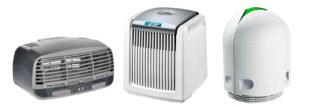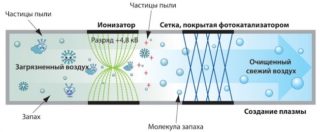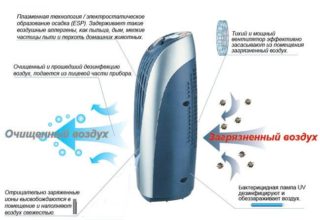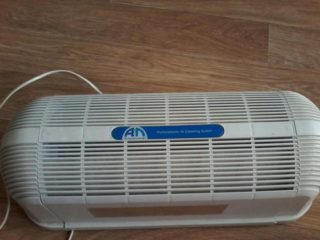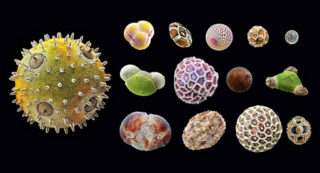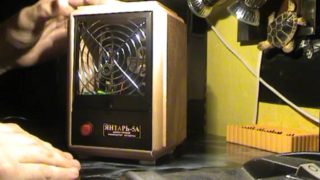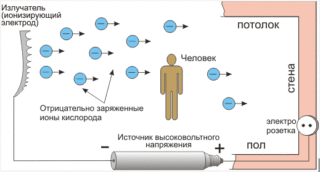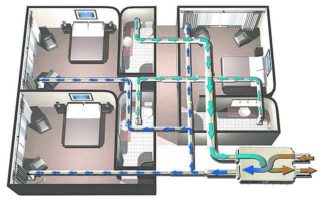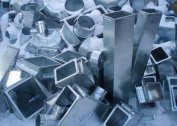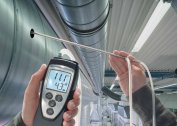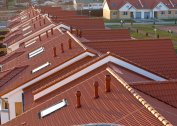The atmosphere of the sea coast, mountains, forests has a beneficial effect on health due to the correct concentration of negative and positive ions. In the gas-polluted metropolis on the streets, in the dwellings there is no optimal ratio of microparticles, therefore an air ionizer is used for the apartment. Negative anions improve the function of the respiratory organs, accelerate blood circulation.
The need, purpose and types of air ionizer
An ionizer is an installation in which air is passed through an electronic device to form ions from neutral molecules or atoms. The device makes up for the number of negatively charged particles in the atmosphere and brings its properties closer to natural indices. As a result of the installation, the risk of hypertension and nervous diseases, weakening of the immune system is reduced.
Types of aeroionizers:
- thermoelectronic;
- radioisotope;
- photovoltaic;
- hydrodynamic;
- effluvial (corona).
Devices operate from a block of ionizing radiation, for example, with a corona discharge or on radioactive isotopes. The ion flux reaches 2-3 billion microparticles per second. Arc and spark discharge are not applicable, as in air, a large amount of nitrogen oxides is obtained.
Ionizing electrodes are of two types:
- needle;
- wire.
An ionizing device quickly cleans the atmosphere of the room, smoke is completely removed in 5-6 minutes, pathogens die in 2-2.5 hours. Aeroionization improves the properties of air, when you turn on dust particles are deposited on solid surfaces and do not enter the respiratory tract.
The principle of operation of the air ionizer
In the endothermic process, positive charges are obtained if energy is transferred to the electron in the molecule to pass through the probable barrier. Negative ions are created when an atom captures an additional electron with the release of energy.
Ultraviolet types give a large amount of ozone and nitric oxides, so they are rarely used for domestic use. Such devices are placed in medical facilities for the disinfection of wards and objects in cells. Hydroionizers generate charged water dust, installations were actively used in the USSR when using distilled water.
Corona discharge devices are equipped with point electrodes that emit ions close to the anodes and cathodes.
Devices are:
- unregulated, which function without control and constantly form microparticles;
- adjustable, whose work is coordinated by changing the strength of the electric field.
Both types are used in modern devices, the units are equipped with blowers (built-in or external) to bring the electric charge together with the ionized stream.
The difference between humidifiers and ionizers
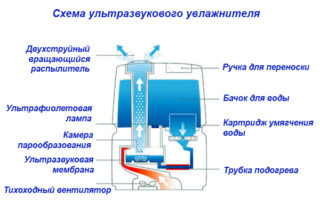 The conclusion about the usefulness of one or the other device cannot be made, because they improve the quality of the atmosphere, but in different ways. The ionizer cleans and freshens the air and does not affect the vapor content, unlike a humidifier. Devices are better to use at the same time.
The conclusion about the usefulness of one or the other device cannot be made, because they improve the quality of the atmosphere, but in different ways. The ionizer cleans and freshens the air and does not affect the vapor content, unlike a humidifier. Devices are better to use at the same time.
Each of the tasks is important for health, therefore there are devices with a combination of functions. If the installation enriches air with ozone and increases the content of water vapor, we can say that this is ionization in a humidifier.Good models work silently, remove the steam stream with a temperature of no more than + 40 ° C and precisely coordinate the humidity.
Climatic humidifiers are used to increase humidity in the room, some at the same time work as a cleaner from harmful additives, enrich with useful elements and aromatize. Humidifiers are steam, traditional and ultrasonic, but all types are combined with a generator of positive and negative ions.
The difference between a bipolar and a simple air ionizer
Ions are called atoms having a negative or positive charge. Neutral or balanced instances have the same number of electrons and protons. The loss of one electron by an atom leads to a positive charge, and the addition of an electron gives a negative potential. Air is considered as a gas mixture in which oxygen, water vapor, nitrogen, hydrocarbon and other species are present, each of which undergoes ionization.
Ionizers are divided into 2 types depending on the type of microparticle generation:
- bipolar - reproduce positive and negative particles;
- unipolar - give out only ions with a negative sign.
Bipolar species use the principle of alpha-ionization using a nuclear source. Microparticles of polonium 210 are in contact with air and transport electrons, forming neutral air molecules with a negative sign. Polonium as a result loses electrons, gains a positive potential and becomes an ion with a + sign.
Unipolar use the principle of coronation ionization, when electricity creates a weakly ionized bipolar air. A high voltage current containing a stream of potential negative electrons passes through a metal tip or prongs. The phenomenon of electrostatic detachment activates the emission of particles from a metal and forces them to combine with oxygen or nitrogen molecules, therefore, negative charges are reproduced in the atmosphere.
Air ionization is enrichment with negative particles, therefore, at home they put bipolar types of devices.
Benefits of Quartz / UV Lamp Ionizer
The basis of the action is UV irradiation of a quartz device, harmful to microorganisms. Sterilization technology is used in medical institutions and food enterprises. Modern devices destroy microorganisms and decompose hazardous organics in the air into water and carbon dioxide. Lamps fight mold and fungi by destroying their spores in the atmosphere.
The basic model contains a fan and a quartz emitter in the design. The turbine pumps the flow, the lamp emits UV rays and disinfects the air, ionizes it, destroys organic compounds and microorganisms, the cleaned jet is removed from the housing.
Lamp Advantages:
- simplicity of management (connection to the power supply, setting the timer);
- no replaceable filters required;
- compactness, low power consumption.
Users are worried about the application because During operation, a large amount of ozone is released. Experts argue that modern installations are safe for animals, humans, because a softer type of radiation is used.
For prevention, care must be taken when handling a quartz device. During operation, the protective cover must not be removed, as radiation causes burns to the skin and mucous membranes of the eyes. The installation is cleaned once a month; the lamp is not placed near combustible substances and objects. Only certified models are allowed.
The benefits and harms of the ionizer
Anions accumulate in space, under their action dust, smoke particles stick together and settle on surfaces. An ionizer is a means to clean the atmosphere, but its use does not cancel the regular wet cleaning.
Benefits of using:
- improves the quality of the microclimate;
- microorganisms are destroyed, the air is cleaned of allergens and organic pollutants;
- harm from electronic devices, for example, computers, TVs, air conditioners, is neutralized.
The disadvantages are manifested in the fact that the frequency of cleaning in the places of installation of the ionizer is becoming more frequent. The device synthesizes ozone, which belongs to the category of oxidizing gases. The substance accumulates in a closed microclimate and is harmful to health. Ionization cannot be done in highly smoked and dusty air in the presence of man.
When it is not recommended to use an ionizer in an apartment
Specialists identified cases when the device can not be turned on to electrify air. Air ions accelerate metabolism, which improves the nutrition of cells, including tumor cells, and leads to the progression of the disease.
The list of diseases in which you can not use a unipolar type of device:
- organic lesions of the nervous system;
- acute phase of rheumatoid arthritis;
- active stage of pneumonia;
- severe circulatory disturbance;
- emphysema;
- severe bronchial asthma;
- depression.
In this case, you need to select a bipolar ionizing device and work with it according to the instructions.
Any type of device cannot be turned on at high body temperature, as health may be worse. If the atmosphere is very smoky or there is visible dust, ionization is carried out without people, until the dust settles on solid surfaces. After wet cleaning, people are allowed.
These circumstances are preventive measures. In other cases, bipolar types improve well-being and improve the microclimate.
Features of use
Molecules of soot, dust and smoke are charged under the action of the device and move to the plus pole, which is the floor, walls, ceiling and other surfaces in the room. Manufacturers argue the use of ionizers by the fact that all these microparticles enter the human body if they are in the air.
Sanitary standards set forth in the document SanPiN 2.2.4.12.94 - 2003:
- minimum permitted concentration of 400 negative or positive ions in 1 cm³ of atmosphere;
- the maximum concentration is allowed at the level of 50 thousand charged particles in 1 cm³ of air.
Ionization initiates the appearance of sediment in the area of solid objects.
Use in the presence of children
Ionizers in the children's room are necessary if the windows of the housing open onto a gassed street and there is no possibility to ventilate the room. The formation of ozone will benefit the child in dry and stale air. The ionizer will facilitate breathing and give freshness to the internal microclimate.
For children, a salt lamp is suitable, which looks stylish and exciting in the interior of the room. When salt is heated, ozonated streams are released from it, which prevent respiratory diseases of the respiratory organs. It is recommended that you install a purifier with a HEPA filter and an integrated ionizing device so that two beneficial processes occur simultaneously.
Effect on newborns
In a house where there are babies, you need to purchase an ionizer with an electrostatic precipitator to trap dust and organic particles. When buying, you need to look at the technical specifications in the passport and pay attention to the number of aeroions produced - it should not be higher than 50 thousand ions.
For a room of a newborn, it is better to purchase a device with a medical certificate. Ions are good for children's health. Sleep improves, metabolic processes in the body accelerate.
Effect on animals in the apartment
Professor Chizhevsky conducted a study of the effect of air ions on animals and concluded that insufficient ions worsen the well-being of pets. They lose body weight, their behavior is characterized by lethargy and indifference.
With artificial ozonation, birds and animals increase litter, their appetite is activated, and the digestibility of food improves. The behavior is friendly and agile.
Disadvantages of the ionizer
When turned on, the level of static electricity increases as a result of using the device in dry air conditions. Heavy ions accumulate in the atmosphere, a phenomenon arising from poorly organized ventilation in the room. Electrified particles can enter the respiratory tract.
The device is placed in a room where there is an influx and outflow of fresh air. Improper placement can cost a person unwell, especially for asthmatics, allergy sufferers, and debilitated people. Continuous work during the day is not recommended, the installation must be turned off at night.
Basic selection rules
First, the type of device is determined, then its technical indicators are studied to compare them with the area of the room.
Attention is paid to the characteristics:
- concentration of charges and maintaining this level at a distance of 1 - 2 meters from the installation;
- ionizer power;
- the recommended operating time from start to shutdown, during this period the air must be completely ionized;
- operating mode, for example, impulsive or continuous;
- packing with nozzles and filters depending on the needs of people living in the house;
- case material - natural wood or high-quality plastic is recommended;
- control method (manual or remote).
If the room is large, the appliance must have the appropriate capacity to process the air at different points. It is better to choose ionizers that work silently.
